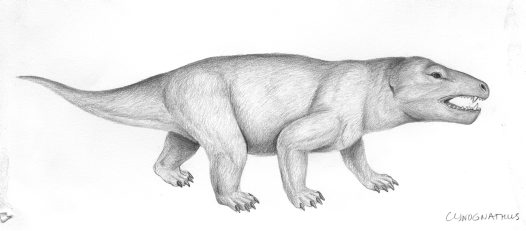 |
 |
 |
 |
 |
Produced
by the Population Genetics and Evolution class, Furman University |
||||
 |
 |
 |
 |
 |
Produced
by the Population Genetics and Evolution class, Furman University |
||||
 |
The
Triassic: Cynognathus |
 |
||
| Cynognathus
were relatively large terrestrial predators that had mammalian and reptilian-like
features. According to fossil records these extinct tetrapodal organisms
grew to about two meters in length (NHM 2010). The most fascinating characteristic
of Cynognathus was their emergence of specialized teeth that
make scientists believe they were carnivorous. Recovered skulls reveal
that they had three distinct types of teeth that allowed them to hunt
and feed with greater efficiency than their previous ancestors. In addition,
they had a special jaw attachment that allowed them to open their mouths
wider (White 2010). These creatures also had an early version of a secondary
palate, which was significant because it allowed the organism to drink
and eat during respiration (AA 2010). Because of these traits, Cynognathus
was a feared predator. Page by Pete Calomiris |
 |
| Cynognathus. Picture Provided By: The Australian Museum | |
| Absolute Astronomy. 1999. Cynognathus. AbsoluteAstronomy.com. Accessed March 2010. Natural History Museum. 2010. Cynognathus crateronotus. nhm.ac.uk. Accessed March 2010. White AT. 2003. Cynodontia: Eucynodontia. Palaeos.org. Accessed March 2010. |